初中英语语法大全——介词(共27张PPT)
文档属性
| 名称 | 初中英语语法大全——介词(共27张PPT) |  | |
| 格式 | ppt | ||
| 文件大小 | 1.9MB | ||
| 资源类型 | 教案 | ||
| 版本资源 | 通用版 | ||
| 科目 | 英语 | ||
| 更新时间 | 2022-04-10 10:33:13 | ||
图片预览


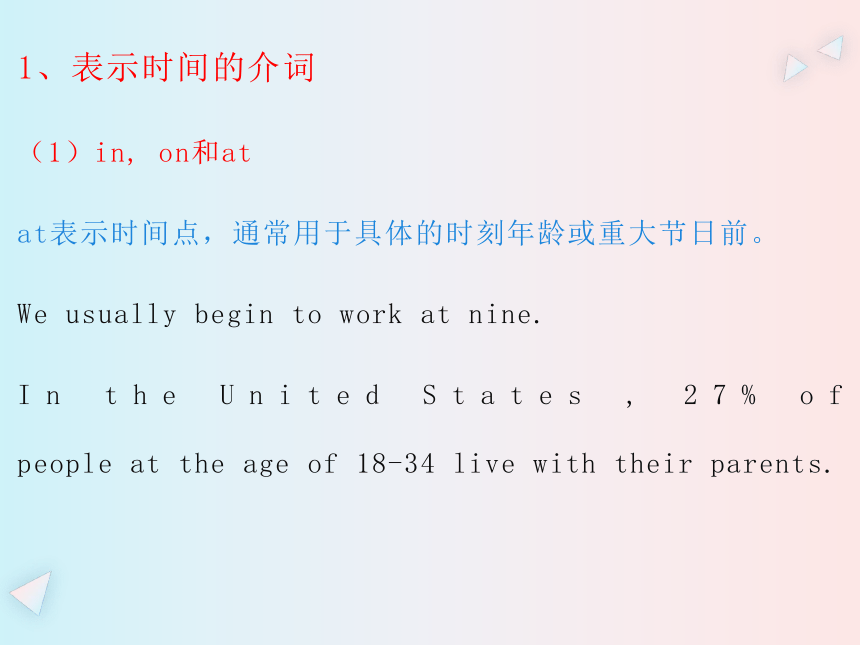

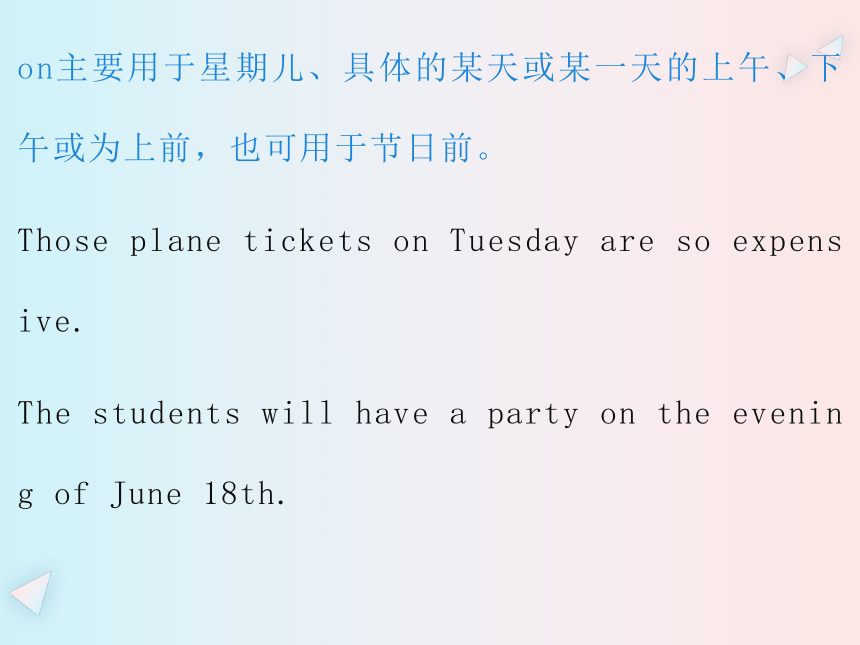
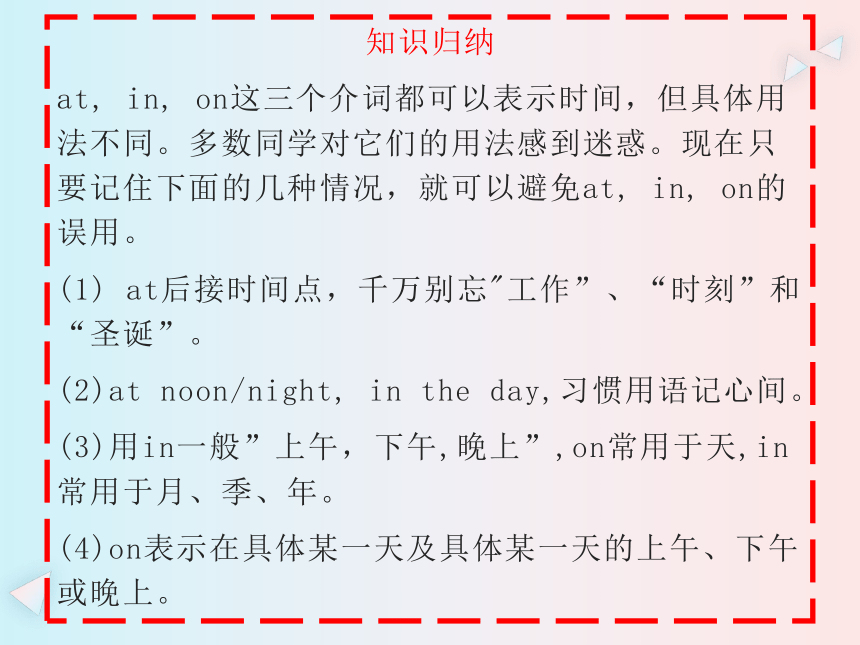
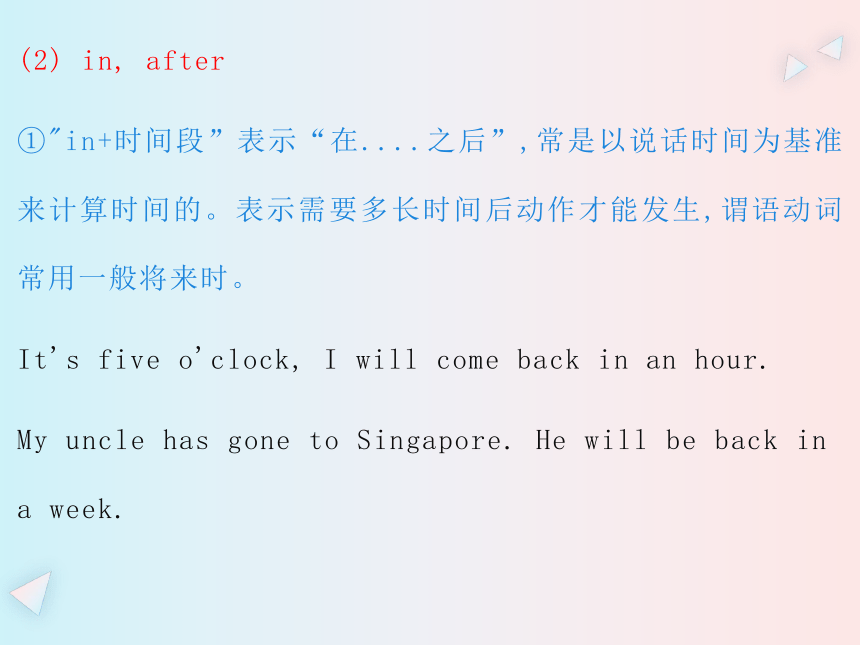
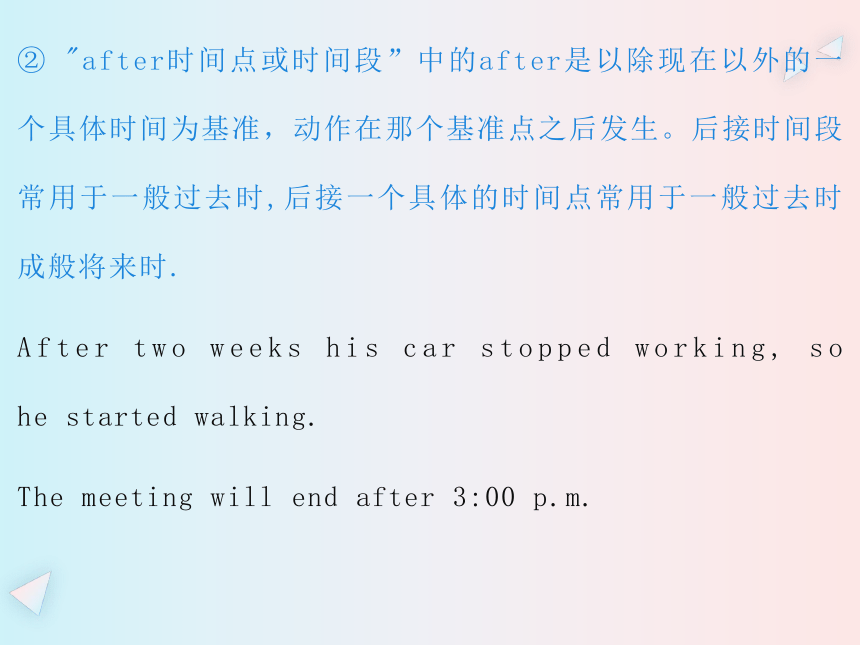

文档简介
(共27张PPT)
初中英语语法大全
介词
介词是一种用来表示词与词、词与句之间关系的词。介词是唐同不能重读,不能在句子中单独作成分,介词后面一般有名词、代词成相当于名词的其他词、短语或从句充当它的宾语。介词及其宾语构成介词短语,在句中充当状语、表语、补足语或定语等成分。
We went home after the experiment.
I have no money about me.
I am all for going skiing.
1、表示时间的介词
(1)in, on和at
at表示时间点,通常用于具体的时刻年龄或重大节日前。
We usually begin to work at nine.
In the United States , 27% of people at the age of 18-34 live with their parents.
in强调时间段,即在较长的一段时间内,后多接表示年代、月份、四季等的名词或泛指某一天的上午、下午或晚上前。in还可表示在将来。
--- Jim, when were you born
--- I was born in October, 1998.
I can be ready in half an hour.
It’s the only letter I’ve had in 10 days.
The street in the early morning is very quiet except for a few cars.
on主要用于星期儿、具体的某天或某一天的上午、下午或为上前,也可用于节日前。
Those plane tickets on Tuesday are so expensive.
The students will have a party on the evening of June 18th.
知识归纳
at, in, on这三个介词都可以表示时间,但具体用法不同。多数同学对它们的用法感到迷惑。现在只要记住下面的几种情况,就可以避免at, in, on的误用。
(1) at后接时间点,千万别忘"工作”、“时刻”和“圣诞”。
(2)at noon/night, in the day,习惯用语记心间。
(3)用in一般”上午,下午,晚上”,on常用于天,in常用于月、季、年。
(4)on表示在具体某一天及具体某一天的上午、下午或晚上。
(2) in, after
①"in+时间段”表示“在....之后”,常是以说话时间为基准来计算时间的。表示需要多长时间后动作才能发生,谓语动词常用一般将来时。
It's five o'clock, I will come back in an hour.
My uncle has gone to Singapore. He will be back in a week.
② "after时间点或时间段”中的after是以除现在以外的一个具体时间为基准,动作在那个基准点之后发生。后接时间段常用于一般过去时,后接一个具体的时间点常用于一般过去时成般将来时.
After two weeks his car stopped working, so he started walking.
The meeting will end after 3:00 p.m.
(3)for, since
① for后接表示段时间的词语,表示动作延续或持续的时间长度,意为“共...时间,用...时间" ,但没有指明具体(发生的)时间。
I have lived in this city for more than ten years.
We will stay in Beijing for two months.
② since用作介词时,意为“自从,...以后",指从某时直延续至今后接时间点,通常与完成时连用,表示一直延续的动作或行为,谓语动词为延续性动词。
The factory has been there since spring 1999.
She hasn't been home since her marriage.
要点提升
since还可用作速词,意为“自从”,引导时间状讲从向,主要用完成时态,从向用一般过去时。
We have been working in this factory since I graduated in 2003.
Great changes have taken place since he left.
(4)by, before, until/till
① by含有“最晚不迟于.....,到....为止”的意思。如果by之后是将来的时间, 则与将来时连用如果是过去的时间,则与过去完成时连用。
The lunch will be ready by 11:00.
This factory had produced more than one million cars by the end.
② before意为“在...之前”,指的是动作具体发生的时间,而不是动作延续的时间,也不是动作最迟的时间限制。
I will be back before supper.
Please come before nine o'clock.
Before eating the apple, I washed it carefully.
③ until/ till用在肯定向中,意为“直到...为止”,谓语动词为延续性动词;用在否定句中,意为”直到.....才”,谓语动词为非延续性动词。在非延续性动词的否定式中,二者可通用,但位于句首
成在强调结构中只用until。
I will work here until/ till six o'clock.
I didn’t leave the boy until/ till his mother turned up.
They didn't leave until/ till it was late.
2. 表示地点、方位的介词
(1 ) above, below, over, under, on
①above意为“在...上方",指离开物体表面而在其上方,但并不一定垂直向上。其反义词是below。
The sun has risen above the horizon.
The plane is flying above the clouds.
②over意为“在...上方",一般强调在正上方。
The bridge over the river has a long history.
Mr.King put a coat over the sleeping girl to keep her warm.
on指与物体表面接触,在某物体的表面上。
Look at the wall.There are some pictures on it.
There are about two hundred students playing on the playground.
(2) in, on, to
①in表示在某范围之内。
Shandong province is in the east of China.
②on表示“接壤”,却互不管辖。
Hebei province is on the north of Henan province.
③to表示在某范围之外,互不接壤,互不管辖。
Jinzhou is to the west of Shenyang.
(3) in, on, at
①in表示“在....里”。表示“在...上时”,暗示占去了某物的一部分。表示地点时,多指较大的地方。
She got in her car and drove off.
There are two windows in the wall.
Einstein was born in a city in southern Germany.
②on意为“在...上面”,强调表面有接触,指在一个平面上。
He put his bag on the bed.
The teacher drew a dog on the blackboard.
③at表示地点时.多指较小的地方或某一点的具体位置。它只是把处所看作是一个没有范围限制的点或者地点,而不是强调“在....内”或“在....上”。
We met at the corner of the street.
We live at No. 87 Bejing Road.我们住在北京路87号。
(4) between, among
① between用于两者之间或者多者以上的两两之间,强调两者之同的关系。between在接三者或三者以上的物体时,是把这些物体分别看待,指每两者之间。
Would you come between eight and nine o'clock
② among用于三者或三者以上之间,其所在范围的人或物通常视为一个整体。
He hes always been popular among his classmates.
(5) in front of, in the front of
①in front of表示在某一空间外部的前面,表示建筑物或者无生命的具体位置时更常用in front of。其反义词是behind。
There is a bank in front of the hotel.
②in the front of表示在某一空间内部的前面。与in front of的区别是弄清楚是在某一个空间的内部还是外部。
He satin the front of the car.他坐在汽车(内)的前部。
(6)across,,through, past
① across强调横越一个平面,表示从一边到另一边,动作是在某物体的表面进行的。
She went across the street to do some shopping.
We will soon be across the Pacific.
② through强调动作在某一物体的内部进行。通常指通过中心的东西(如管道等),或者是立体的空间或物体(如树林、人群等)。through也可用来表示穿越一个障码物(如门、窗等)。
The moonlight goes through the window and makes the room bright.
The signals can go through glass doors and walls.
③past强调从某一物体的旁边经过,常与动态动词连用。
They drove past a big supermarket.
Someone has just gone past the window.
(7)into, onto, out of和off的用法
into 表示进入; onto表示到另一个平面上; out of表示“从...出来”; off表示脱离某一地方。
The girl threw a stone into the river.
I saw Lucy run into the hall and very soon come out of it.
Wendy, don't jump onto the desk, will you
3.其他常考介词的用法
(1) except, besides
①except表示“....之外(其余都)”,,其后的宾语被排除在外。所排除的与所谈论的应为同类的人或者物,指从整体中除去一部分。
Tom failed in the exam. Expect him, all the others succeeded.
② besides意为“除...之外(还)...”,其宾语是被包含在整体之内的部分。
There are in China over fifty minorities besides the Han nationality.
(2) 表示方式手段的by, with, in
①by表示用某种方式或手段、途径等.后接名词代词或动名词,也可和表示交通工具的名词连用。
I study English by listening to tapes.
② with表示"....工具,手段”,一般接具体的工具或手段。也可表示伴随动作的态度表情、心境等。
People want to throw away heavy schoolbags and read with small, light e-readers.
③in某种材料波语言声音等或者表示心理活动(如情绪、心情态度等)。
Don’t write it in English. Write it in ink, please.
He can say it in English.
The student marched the farm in the high spirits.
初中英语语法大全
介词
介词是一种用来表示词与词、词与句之间关系的词。介词是唐同不能重读,不能在句子中单独作成分,介词后面一般有名词、代词成相当于名词的其他词、短语或从句充当它的宾语。介词及其宾语构成介词短语,在句中充当状语、表语、补足语或定语等成分。
We went home after the experiment.
I have no money about me.
I am all for going skiing.
1、表示时间的介词
(1)in, on和at
at表示时间点,通常用于具体的时刻年龄或重大节日前。
We usually begin to work at nine.
In the United States , 27% of people at the age of 18-34 live with their parents.
in强调时间段,即在较长的一段时间内,后多接表示年代、月份、四季等的名词或泛指某一天的上午、下午或晚上前。in还可表示在将来。
--- Jim, when were you born
--- I was born in October, 1998.
I can be ready in half an hour.
It’s the only letter I’ve had in 10 days.
The street in the early morning is very quiet except for a few cars.
on主要用于星期儿、具体的某天或某一天的上午、下午或为上前,也可用于节日前。
Those plane tickets on Tuesday are so expensive.
The students will have a party on the evening of June 18th.
知识归纳
at, in, on这三个介词都可以表示时间,但具体用法不同。多数同学对它们的用法感到迷惑。现在只要记住下面的几种情况,就可以避免at, in, on的误用。
(1) at后接时间点,千万别忘"工作”、“时刻”和“圣诞”。
(2)at noon/night, in the day,习惯用语记心间。
(3)用in一般”上午,下午,晚上”,on常用于天,in常用于月、季、年。
(4)on表示在具体某一天及具体某一天的上午、下午或晚上。
(2) in, after
①"in+时间段”表示“在....之后”,常是以说话时间为基准来计算时间的。表示需要多长时间后动作才能发生,谓语动词常用一般将来时。
It's five o'clock, I will come back in an hour.
My uncle has gone to Singapore. He will be back in a week.
② "after时间点或时间段”中的after是以除现在以外的一个具体时间为基准,动作在那个基准点之后发生。后接时间段常用于一般过去时,后接一个具体的时间点常用于一般过去时成般将来时.
After two weeks his car stopped working, so he started walking.
The meeting will end after 3:00 p.m.
(3)for, since
① for后接表示段时间的词语,表示动作延续或持续的时间长度,意为“共...时间,用...时间" ,但没有指明具体(发生的)时间。
I have lived in this city for more than ten years.
We will stay in Beijing for two months.
② since用作介词时,意为“自从,...以后",指从某时直延续至今后接时间点,通常与完成时连用,表示一直延续的动作或行为,谓语动词为延续性动词。
The factory has been there since spring 1999.
She hasn't been home since her marriage.
要点提升
since还可用作速词,意为“自从”,引导时间状讲从向,主要用完成时态,从向用一般过去时。
We have been working in this factory since I graduated in 2003.
Great changes have taken place since he left.
(4)by, before, until/till
① by含有“最晚不迟于.....,到....为止”的意思。如果by之后是将来的时间, 则与将来时连用如果是过去的时间,则与过去完成时连用。
The lunch will be ready by 11:00.
This factory had produced more than one million cars by the end.
② before意为“在...之前”,指的是动作具体发生的时间,而不是动作延续的时间,也不是动作最迟的时间限制。
I will be back before supper.
Please come before nine o'clock.
Before eating the apple, I washed it carefully.
③ until/ till用在肯定向中,意为“直到...为止”,谓语动词为延续性动词;用在否定句中,意为”直到.....才”,谓语动词为非延续性动词。在非延续性动词的否定式中,二者可通用,但位于句首
成在强调结构中只用until。
I will work here until/ till six o'clock.
I didn’t leave the boy until/ till his mother turned up.
They didn't leave until/ till it was late.
2. 表示地点、方位的介词
(1 ) above, below, over, under, on
①above意为“在...上方",指离开物体表面而在其上方,但并不一定垂直向上。其反义词是below。
The sun has risen above the horizon.
The plane is flying above the clouds.
②over意为“在...上方",一般强调在正上方。
The bridge over the river has a long history.
Mr.King put a coat over the sleeping girl to keep her warm.
on指与物体表面接触,在某物体的表面上。
Look at the wall.There are some pictures on it.
There are about two hundred students playing on the playground.
(2) in, on, to
①in表示在某范围之内。
Shandong province is in the east of China.
②on表示“接壤”,却互不管辖。
Hebei province is on the north of Henan province.
③to表示在某范围之外,互不接壤,互不管辖。
Jinzhou is to the west of Shenyang.
(3) in, on, at
①in表示“在....里”。表示“在...上时”,暗示占去了某物的一部分。表示地点时,多指较大的地方。
She got in her car and drove off.
There are two windows in the wall.
Einstein was born in a city in southern Germany.
②on意为“在...上面”,强调表面有接触,指在一个平面上。
He put his bag on the bed.
The teacher drew a dog on the blackboard.
③at表示地点时.多指较小的地方或某一点的具体位置。它只是把处所看作是一个没有范围限制的点或者地点,而不是强调“在....内”或“在....上”。
We met at the corner of the street.
We live at No. 87 Bejing Road.我们住在北京路87号。
(4) between, among
① between用于两者之间或者多者以上的两两之间,强调两者之同的关系。between在接三者或三者以上的物体时,是把这些物体分别看待,指每两者之间。
Would you come between eight and nine o'clock
② among用于三者或三者以上之间,其所在范围的人或物通常视为一个整体。
He hes always been popular among his classmates.
(5) in front of, in the front of
①in front of表示在某一空间外部的前面,表示建筑物或者无生命的具体位置时更常用in front of。其反义词是behind。
There is a bank in front of the hotel.
②in the front of表示在某一空间内部的前面。与in front of的区别是弄清楚是在某一个空间的内部还是外部。
He satin the front of the car.他坐在汽车(内)的前部。
(6)across,,through, past
① across强调横越一个平面,表示从一边到另一边,动作是在某物体的表面进行的。
She went across the street to do some shopping.
We will soon be across the Pacific.
② through强调动作在某一物体的内部进行。通常指通过中心的东西(如管道等),或者是立体的空间或物体(如树林、人群等)。through也可用来表示穿越一个障码物(如门、窗等)。
The moonlight goes through the window and makes the room bright.
The signals can go through glass doors and walls.
③past强调从某一物体的旁边经过,常与动态动词连用。
They drove past a big supermarket.
Someone has just gone past the window.
(7)into, onto, out of和off的用法
into 表示进入; onto表示到另一个平面上; out of表示“从...出来”; off表示脱离某一地方。
The girl threw a stone into the river.
I saw Lucy run into the hall and very soon come out of it.
Wendy, don't jump onto the desk, will you
3.其他常考介词的用法
(1) except, besides
①except表示“....之外(其余都)”,,其后的宾语被排除在外。所排除的与所谈论的应为同类的人或者物,指从整体中除去一部分。
Tom failed in the exam. Expect him, all the others succeeded.
② besides意为“除...之外(还)...”,其宾语是被包含在整体之内的部分。
There are in China over fifty minorities besides the Han nationality.
(2) 表示方式手段的by, with, in
①by表示用某种方式或手段、途径等.后接名词代词或动名词,也可和表示交通工具的名词连用。
I study English by listening to tapes.
② with表示"....工具,手段”,一般接具体的工具或手段。也可表示伴随动作的态度表情、心境等。
People want to throw away heavy schoolbags and read with small, light e-readers.
③in某种材料波语言声音等或者表示心理活动(如情绪、心情态度等)。
Don’t write it in English. Write it in ink, please.
He can say it in English.
The student marched the farm in the high spirits.
同课章节目录
- 词法
- 名词
- 动词和动词短语
- 动词语态
- 动词时态
- 助动词和情态动词
- 非谓语动词
- 冠词
- 代词
- 数词和量词
- 形容词副词及其比较等级
- 介词和介词短语
- 连词和感叹词
- 构词法
- 相似、相近词比较
- 句法
- 陈述句
- 一般疑问句和否定疑问句
- 特殊疑问句及选择疑问句
- 反意疑问句
- 存在句(There be句型)
- 宾语从句
- 定语从句
- 状语从句
- 主谓一致问题
- 简单句
- 并列句
- 复合句
- 主谓一致
- 主、表语从句
- 名词性从句
- 直接引语和间接引语
- 虚拟语气
- 感叹句
- 强调句
- 倒装句
- 祈使句
- 句子的成分
- 句子的分类
- 题型专区
- 单项选择部分
- 易错题
- 完形填空
- 阅读理解
- 词汇练习
- 听说训练
- 句型转换
- 补全对话
- 短文改错
- 翻译
- 书面表达
- 任务型阅读
- 语法填空
- 其他资料
